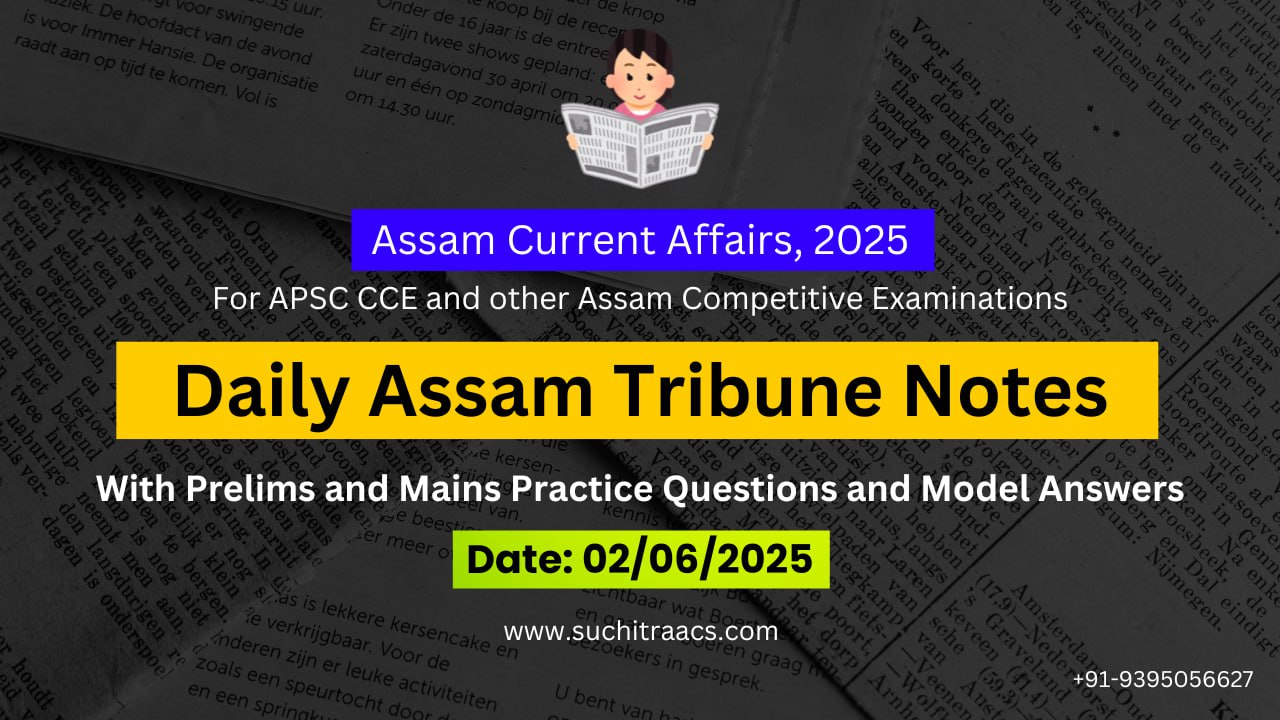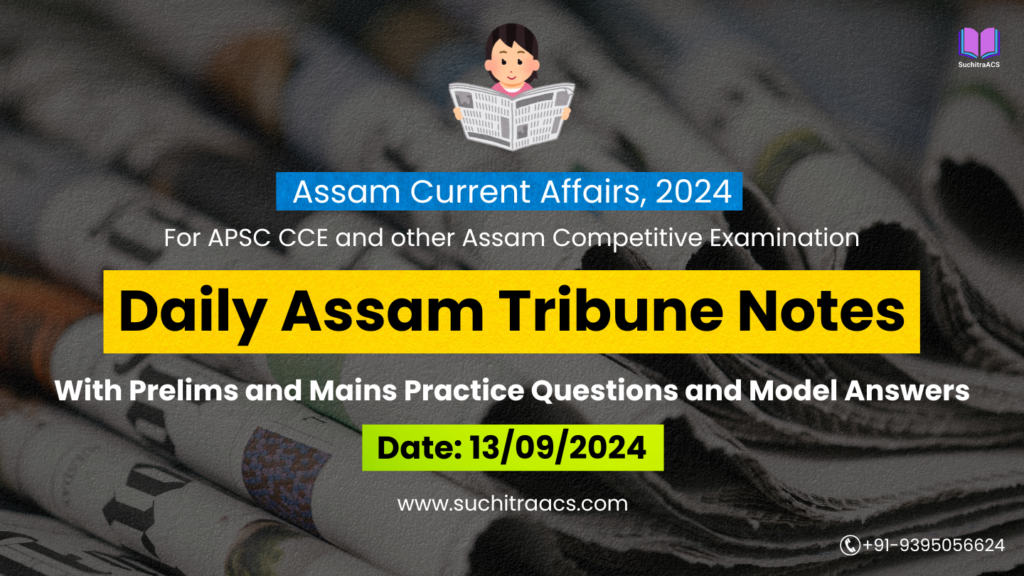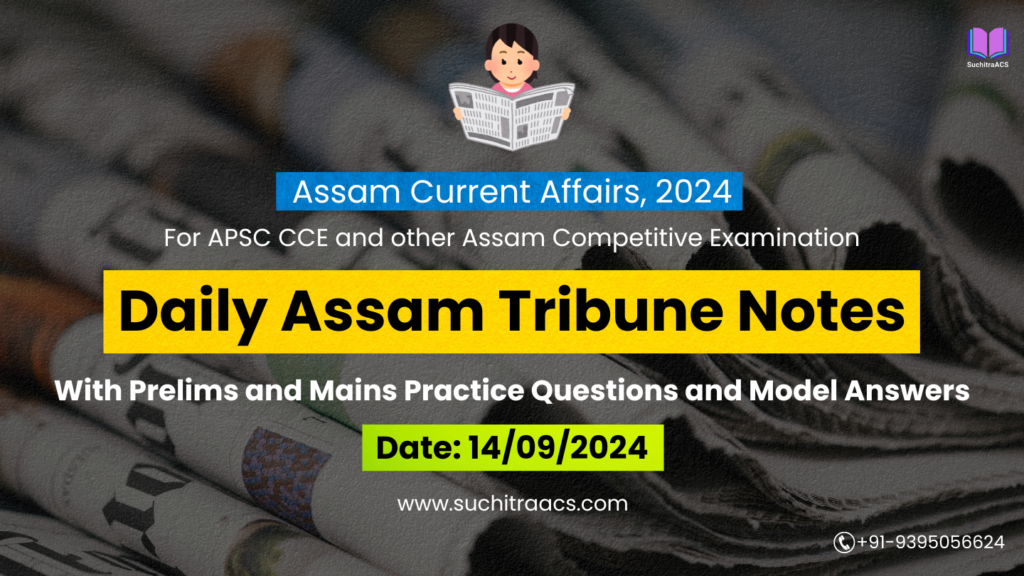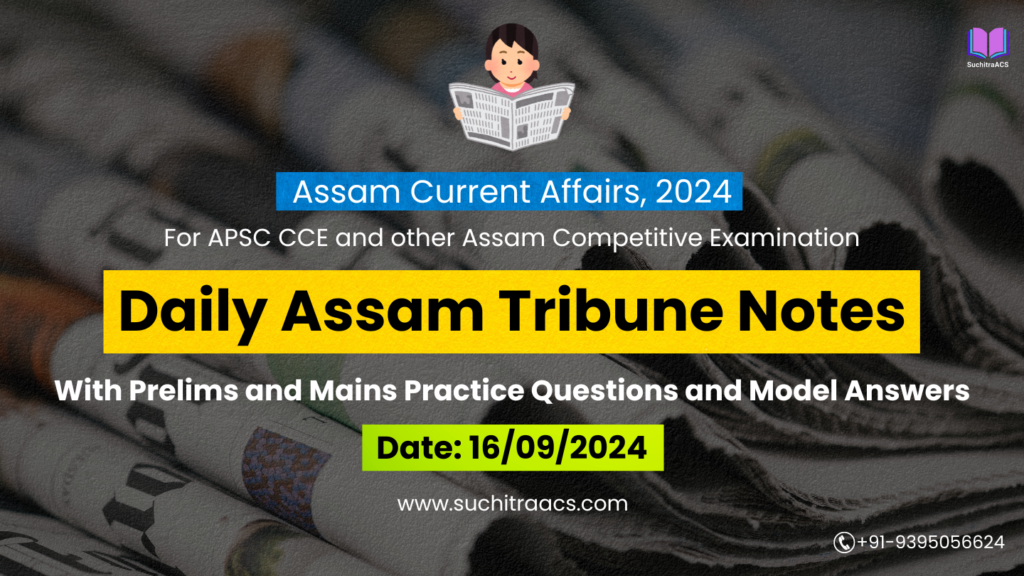APSC Current Affairs: Assam Tribune Notes with MCQs and Answer Writing (30/05/2025)
For APSC CCE and other Assam Competitive examinations aspirants, staying updated with current affairs is vital. This blog covers most important topics from the Assam Tribune today (02-06-2025). These issues are key for both APSC Prelims and Mains preparation, offering insights into the APSC CCE Syllabus.
✨ APSC CCE Online Coaching, 2026

🌊 Grim Flood Situation in Assam: A Disaster Management Challenge
📘 GS Paper 3: Disaster Management | Environment & Ecology
📘 GS Paper 2: Governance | Centre-State Relations | Emergency Response
📘 GS Paper 5 (APSC): Assam – Geography | Floods | Government Initiatives
🔹 Introduction
Assam is once again grappling with severe monsoon floods, with over 3.64 lakh people affected across 19 districts and at least 10 lives lost. Major rivers like the Brahmaputra, Barak, and Dhansiri are flowing above danger levels. The Union Home Minister has intervened with assurance of central assistance. The annual recurrence of such a crisis highlights Assam’s chronic flood vulnerability, inadequate preparedness, and the need for sustainable solutions.
🔑 Key Points
| Detail | Description |
| People Affected | Over 3.64 lakh people in 19 districts |
| Fatalities | 10 deaths reported (5 in floods, 5 in landslides) |
| Major Rivers Above Danger Mark | Brahmaputra (Dibrugarh, Nematighat), Barak, Dhansiri, Buridehing, Katakhal, etc. |
| Key Affected Areas | Lakhimpur, Kamrup, Cachar, Hailakandi, Golaghat, Jorhat |
| Transport Disruption | NH-17 submerged, train & ferry services cancelled |
| Govt. Response | Relief camps, ASDMA alert, SDRF teams deployed, emergency meeting by CM & MoS |
🧠 Prelims Pointers
Brahmaputra River System: Flows from Tibet into Arunachal Pradesh, Assam, and Bangladesh.
Barak River: Major river in southern Assam (Barak Valley), tributary of Meghna in Bangladesh.
ASDMA: Assam State Disaster Management Authority – nodal agency for disaster planning and response.
Orange Alert (CWC): Issued when water levels are above warning level but below danger level; floods likely.
Mission Basundhara: Assam govt initiative for digitizing land records – affects flood planning via accurate maps.
📝 Mains Pointers
A. Significance of the Flood Event
Demonstrates vulnerability of Assam’s terrain and climatic conditions
Disrupts education, transport, agriculture, and healthcare in affected districts
Pushes thousands into relief camps and temporary shelters
Flood-affected communities suffer economic and psychological setbacks annually
Increasing intensity likely linked to climate change and river siltation patterns
B. Challenges in Flood Management
| Challenge | Explanation |
| River Siltation & Changing Flows | High sedimentation reduces water-carrying capacity; Brahmaputra highly braided |
| Encroachments on Riverbeds | Illegal settlements reduce natural floodplains |
| Deforestation in Catchment Areas | Loss of upstream forest cover leads to increased runoff |
| Poor Drainage & Embankments | Weak embankments and clogged natural channels worsen flooding |
| Inter-State Coordination Issues | Inflow from Meghalaya and Arunachal Pradesh complicates flood dynamics |
C. Government Initiatives
ASDMA & SDRF Deployment: State-level response teams activated in advance
Relief Camps Setup: Over 45,000 people sheltered; 411 camps identified in Kamrup district
Emergency Meetings: Involving multiple departments (PWD, Water Resources, Health, Animal Husbandry, PHED)
Flood Monitoring: CWC bulletins and IMD rainfall alerts
Central Assistance: Union Home Minister Amit Shah personally contacted CM Sarma for support
Mission Basundhara 3.0: Used for land mapping, infrastructure vulnerability analysis
D. Way Forward
🛠️ River Basin Management: Joint flood control strategy with Arunachal and Meghalaya
🧱 Strengthen Embankments: Use geotextiles and modern flood-resistant designs
📡 GIS-Based Flood Modelling: Install real-time rainfall/runoff systems across Brahmaputra basin
🚧 Strict Land Use Regulation: Enforce flood zone development norms, remove illegal encroachments
🌳 Watershed Rejuvenation: Afforestation in upper catchments of rivers
🧾 Community-Based Disaster Response Teams: Training locals under ‘Apada Mitra’ initiative
🚤 Modernize Relief Infrastructure: Floating medical units, mobile toilets, solar lights in relief camps
📑 Policy References & Reports
Assam State Action Plan on Climate Change (SAPCC) – Floods classified as top climate risk
National Disaster Management Plan (NDMP) – 2019 revision includes urban floods and flash floods
CAG Audit on Flood Control in Assam (2020) – Pointed out delays, corruption, and poor embankment design
Brahmaputra Board Act – Mandates inter-state flood management under the Ministry of Jal Shakti
🧩 Conclusion
Assam’s flood crisis is no longer a natural disaster, but a result of governance deficits, unregulated development, and ecological neglect. While the state’s immediate response shows improvement, a long-term basin-wide strategy combining science, infrastructure, and community preparedness is essential to protect lives and livelihoods. The floods of 2025 must be a turning point toward resilient development.
🍃 EU’s Green Regulation Threatens Assam’s Tea Exports
📘 GS Paper 2: International Relations | Trade Agreements & External Policies
📘 GS Paper 3: Economy | Agriculture & Exports | Environmental Compliance
📘 GS Paper 5 (APSC): Assam Economy | Tea Industry | Global Trade
🔹 Introduction
Assam’s tea industry—already under strain from low prices and import competition—is facing a new hurdle: the European Union’s Deforestation-Free Regulation (EUDR), which will come into effect from January 1, 2025. The regulation mandates that all imports into the EU (including tea) must not be associated with deforestation or forest degradation post-2020. This could significantly impact small tea growers and exporters in Assam who lack traceability infrastructure.
🔑 Key Points
| Element | Description |
| Regulation | EU Deforestation-Free Regulation (EUDR) |
| Effective From | January 1, 2025 |
| Target Commodities | Tea, Coffee, Cocoa, Rubber, Soya, Palm Oil, Timber, etc. |
| Key Requirement | Proof of “deforestation-free origin” for all exports to EU |
| Risk for Assam | Small tea growers lack traceability, face potential export bans |
| Export Volume | EU is one of India’s top 3 markets for tea exports |
🌱 What the EUDR Demands
Geolocation of the farm/plantation used to produce the tea
Satellite data or records to prove no forest was cleared post-2020
Supply chain traceability from field to export
🧠 Prelims Pointers
Tea Board of India: Statutory body responsible for promotion, certification, export of Indian tea
Geographical Indication (GI): Assam Orthodox Tea holds GI tag
IIT-Guwahati Pilot: Assam has initiated pilot studies for tea traceability using blockchain
Carbon Border Adjustment Mechanism (CBAM): Another EU regulation affecting carbon-intensive imports
Assam Tea Export Markets: UK, EU, UAE, Russia, and Japan
📝 Mains Pointers
A. Significance of the Issue
Assam contributes over 50% of India’s total tea output
EU market contributes significantly to premium Assam Orthodox exports
EUDR introduces a non-tariff barrier under the guise of environmental standards
Could affect livelihoods of 2 lakh+ small tea growers and the entire tea value chain
B. Challenges for Assam’s Tea Sector
| Challenge | Explanation |
| Lack of Traceability | Small growers don’t maintain GPS or digital land ownership records |
| No Common Traceability System | Fragmented data between Tea Board, buyers, and cooperatives |
| Deforestation Legacy Issues | Some tea plantations expanded into forested areas prior to 2020 |
| High Certification Costs | EU-compliant certification is expensive for small growers |
| Policy Vacuum | No Assam-specific roadmap yet for EUDR compliance |
C. Government and Industry Responses
Tea Board engaging with Commerce Ministry and EU embassies for clarifications
Pilot projects on traceability using GIS and blockchain tech
Awareness campaigns launched by Indian Tea Exporters Association (ITEA)
FTA negotiations with EU include discussion on mutual recognition of standards
Industry lobbies demand a grace period or financial aid to meet EUDR norms
D. Way Forward
📍 Create a central traceability portal linked to land records and GI tagging
📦 Form Assam Tea Sustainability Task Force to support small growers
💶 Provide financial assistance/subsidy for EUDR certification & audits
🌍 Coordinate with EU negotiators for phased implementation & equivalency recognition
🧪 Set up local soil, satellite, and residue testing labs in Assam’s tea belts
👩🌾 Encourage tea producer cooperatives to ensure pooled compliance mechanisms
📑 Relevant Policies & Reports
India-EU FTA (BTIA) Negotiations – stalled since 2007, now revived
EU Green Deal – aims to make EU carbon-neutral by 2050; trade-linked regulations
WTO Agreement on Technical Barriers to Trade (TBT) – regulates such non-tariff measures
Tea Development and Promotion Scheme – MoC scheme for quality improvement and export promotion
Assam Tea Industries Special Incentive Scheme (ATISIS) – provides infrastructure and subsidy support
🧩 Conclusion
The EU’s green regulation, while environmentally commendable, could act as a barrier to Assam’s tea economy unless handled proactively. Assam must blend traditional excellence with digital traceability, ensuring its legacy product remains competitive in a green-conscious global market. Collaboration between government, growers, and tech innovators is essential to meet the challenge.
⛰️ Kamrup Metro Launches Hill-Cutting Alarm System to Prevent Urban Landslides
📘 GS Paper 3: Disaster Management | Environment & Urban Issues
📘 GS Paper 2: Governance | Municipal Administration | Technology in Governance
📘 GS Paper 5 (APSC): Assam – Urban Governance | Climate Adaptation | Land Management
🔹 Introduction
In response to increasing incidents of landslides and artificial flooding, especially during the monsoon, the Kamrup Metropolitan district administration has launched a Real-Time Hill Cutting Detection and Alarm System. This tech-driven initiative, the first of its kind in Assam, aims to prevent illegal hill-cutting, which has become a major cause of urban landslides and slope destabilization in and around Guwahati.
🔑 Key Points
| Element | Description |
| Initiative By | Kamrup Metro District Administration |
| Technology Used | Real-time motion sensors, geospatial mapping, automated alerts |
| Problem Addressed | Illegal hill-cutting, soil erosion, landslides, and rain-induced slope failure |
| Target Areas | Hill slopes in East and South Guwahati (e.g., Khanapara, Hengrabari, Narakasur Hills) |
| Additional Measures | Drone surveillance, patrolling teams, monitoring high-risk sites |
🌍 Background Context
Guwahati’s expansion has encroached upon ecologically sensitive hills.
Unregulated real estate has triggered illegal excavation and cutting of slopes.
The monsoon intensifies slope instability, leading to deadly landslides and erosion.
Past landslides in Guwahati (e.g., 2022 at Boragaon) have caused loss of life and property.
🧠 Prelims Pointers
Landslide-Prone Zones: Classified by NDMA based on topography and rainfall; Guwahati falls in moderate-risk zone.
Hill Cutting Regulation: Prohibited under Environment (Protection) Act, 1986 and Guwahati Building Construction Bye-Laws.
Disaster Management Act, 2005: Empowers local administration to take preventive action against hazard creation.
Retaining Wall Design: Used to stabilize hill slopes using RCC or geotextile techniques.
Smart City Technology Use Cases: Includes sensors for flood, landslide, and traffic monitoring.
📝 Mains Pointers
A. Importance of the Initiative
Prevention over response: Early detection of excavation prevents disaster
Promotes eco-sensitive urban governance in a hilly city like Guwahati
Leverages technology and GIS tools to monitor unregulated activity
Reduces risks to lives in densely populated hill-adjacent colonies
Aligns with NDMA and Urban Resilience Missions under the Ministry of Housing & Urban Affairs
B. Challenges in Implementation
| Challenge | Explanation |
| Encroachment on Hill Slopes | Informal settlements on fragile land increase vulnerability |
| Political Resistance | Action against illegal construction often faces local pushback |
| Limited Awareness | Public unaware of slope safety norms or penalties for violations |
| Enforcement Gaps | Shortage of trained staff for monitoring, inspection, and prosecution |
| Fragmented Urban Governance | Multiple agencies (GMDA, GMC, PWD) work in silos |
C. Complementary Government Actions
Drone Surveillance of high-risk hill zones initiated by DC Office
GMC Crackdown on Illegal Constructions post-heavy rains (2023-24)
Building Safety Audits conducted in schools and public buildings near slopes
Integration with AMRUT & Smart City Missions to fund resilience projects
Awareness Drives in urban wards about disaster risk reduction (DRR)
D. Way Forward
📡 Expand sensor-based monitoring to other landslide-prone districts (e.g., Dima Hasao, Karbi Anglong)
🧾 Create a public GIS portal showing landslide zones and construction permissions
📢 Enforce public disclosure of hill-cutting violations and penalties under Disaster Act
🧱 Retrofit existing risky buildings with retaining walls and slope-stabilization structures
🏘️ Promote vertical, regulated development instead of horizontal hill encroachment
👥 Set up ward-level disaster monitoring groups linked to ASDMA
📑 Relevant Frameworks & Reports
NDMA Guidelines on Landslides & Snow Avalanches (2009)
Urban Risk Reduction Plan (MoHUA) under Smart City Mission
CAG Report on Guwahati Drainage & Landslide Management (2021)
State Disaster Risk Reduction Roadmap (Assam SAPCC)
UNDRR Framework on Urban Resilience and Risk Assessment
🧩 Conclusion
The real-time hill-cutting alarm system marks a crucial step in preventive urban disaster governance. As Guwahati urbanizes rapidly, balancing development with environmental safety is essential. This initiative must be scaled, supported by law enforcement, and integrated with community engagement to make Assam’s capital resilient to climate and topographical risks.
⚡ Subansiri Hydel Project Safety Under Scrutiny Amid Public Concerns
📘 GS Paper 3: Infrastructure | Disaster Management | Energy Security
📘 GS Paper 2: Governance | Centre-State Relations | Environmental Governance
📘 GS Paper 5 (APSC): Assam – Hydroelectric Projects | Environment | North-East Development
🔹 Introduction
Amid rising public apprehensions, the National Hydroelectric Power Corporation (NHPC) has reasserted the safety and structural integrity of the Lower Subansiri Hydroelectric Project (LSHEP) located on the Assam-Arunachal border. Locals and environmentalists have raised concerns due to the project’s location in a seismically active region and the potential downstream impact on Assam’s flood plains. NHPC officials conducted an awareness program in Dhemaji, explaining safety features and operational protocols.
🔑 Key Points
| Feature | Description |
| Project Name | Lower Subansiri Hydroelectric Project (LSHEP) |
| Location | Gerukamukh (on Assam-Arunachal border) |
| River | Subansiri (largest tributary of Brahmaputra) |
| Capacity | 2,000 MW (India’s largest under-construction hydropower project) |
| Concern Raised By | Local residents, environmental groups, engineers |
| NHPC’s Assurance | Project designed for seismic Zone V; multiple fail-safe mechanisms |
🧠 Prelims Pointers
Subansiri River: Originates in Tibet, enters Arunachal Pradesh, joins Brahmaputra in Assam
NHPC: PSU under the Ministry of Power, responsible for hydroelectric projects in India
Seismic Zone V: Highest seismic risk classification under India’s earthquake zoning map
EIA (Environmental Impact Assessment): Required for large hydro projects under 2006 notification
MoEFCC: Grants environmental clearance for such projects
📝 Mains Pointers
A. Significance of the Project
Will generate 2,000 MW of clean, renewable energy, reducing fossil fuel dependence
Strategically located to power North East states and feed into the national grid
Boosts employment, connectivity, and development in border districts
Can aid in moderating Brahmaputra’s flow during lean season if managed carefully
B. Key Concerns and Risks
| Concern | Explanation |
| Seismic Risk | Located in Zone V; possibility of dam breach during major earthquake |
| Siltation and Sediment Load | Subansiri has high sedimentation rate; risk of reducing reservoir life |
| Flood Impact | Sudden release of water could trigger flash floods in Assam |
| Biodiversity Loss | Threat to riverine and aquatic species (e.g., Golden Mahseer) |
| Displacement & Livelihood Loss | Affects riverine communities and agriculture downstream |
C. Safety & Design Measures
NHPC claims dam can withstand 8+ magnitude earthquakes
Installed emergency spillways and shock-absorbing structures
Regular dam health monitoring through seismographs and automated sensors
Emergency Action Plans (EAPs) shared with district administrations
Capacity to regulate Brahmaputra’s flow without flooding, if managed correctly
D. Government & Legal Responses
Project delayed for over a decade due to protests and legal cases
Clearance reissued by MoEFCC with enhanced mitigation measures
Assam and Arunachal govts involved in joint risk assessments and community consultations
National Green Tribunal (NGT) oversight during construction phase
E. Way Forward
📊 Conduct third-party safety audits involving independent geologists and civil engineers
🛑 Ensure public transparency and community participation in operational protocols
🛰️ Deploy real-time flood monitoring systems and public early warning systems
📚 Launch awareness programs in flood-prone villages about dam safety drills
🌿 Compensate for ecological loss with catchment-area afforestation and biodiversity offsets
🤝 Foster interstate coordination between Assam and Arunachal on water governance
📑 Relevant Reports & Policies
Draft National Hydropower Policy (2018)
Assam Disaster Risk Reduction Roadmap
Environmental Management Plan (EMP) for LSHEP
CAG Report on Delay in Hydropower Projects (2022)
UN Sendai Framework for Disaster Risk Reduction (2015–30)
🧩 Conclusion
While the Lower Subansiri project represents a major step toward energy security and clean power, its success depends on public trust, seismic preparedness, and transparent governance. Assam’s geography makes caution imperative. Ensuring community confidence and real-time risk management will be the key to reconciling development with disaster safety.
APSC Prelims Practice Questions
✅ Topic 1: Grim Flood Situation in Assam
1. Which of the following are correct causes of recurrent floods in Assam?
- Braided nature of the Brahmaputra
- High sediment load from Himalayan rivers
- Unregulated construction on floodplains
- Low annual rainfall in monsoon season
Select the correct code:
A. 1 and 2 only
B. 1, 2 and 3 only ✅
C. 2, 3 and 4 only
D. 1, 2, 3 and 4
🧠 Explanation:
Low rainfall (Statement 4) is incorrect—Assam receives high monsoon rainfall. The other three are established causes of floods in Assam.
2. “Mission Basundhara”, often seen in the context of Assam, primarily aims at:
A. Providing universal healthcare in flood-affected areas
B. River rejuvenation and silt removal
C. Digitization and settlement of land records ✅
D. Distribution of disaster relief kits
🧠 Explanation:
Mission Basundhara is a flagship land governance reform project by the Assam government focusing on digitizing land records and clearing land rights disputes.
✅ Topic 2: EU Deforestation-Free Regulation & Assam Tea Exports
3. Which of the following commodities are regulated under the EU’s Deforestation-Free Regulation (EUDR)?
- Tea
- Coffee
- Palm oil
- Rice
Select the correct code:
A. 1, 2 and 3 only ✅
B. 1 and 2 only
C. 2 and 3 only
D. All four
🧠 Explanation:
Rice is not part of the EUDR. Tea, coffee, palm oil, cocoa, rubber, timber, and soya are included.
4. Assertion (A): The EU’s green regulations could impact Assam’s tea exports significantly.
Reason (R): Small tea growers in Assam have well-established geolocation-based traceability systems.
Choose the correct answer:
A. Both A and R are true, and R is the correct explanation
B. Both A and R are true, but R is not the correct explanation
C. A is true, but R is false ✅
D. A is false, but R is true
🧠 Explanation:
A is true: EUDR affects Assam tea. R is false: Small tea growers lack traceability, making compliance hard.
✅ Topic 3: Kamrup Metro’s Hill-Cutting Alarm System
5. Which of the following are features of Guwahati’s hill-cutting early warning system launched in 2025?
- Motion sensors for slope movement
- Drone surveillance over hill areas
- Public alert system via mobile SMS
- Use of AI-based predictive modeling
Select the correct code:
A. 1 and 2 only
B. 1, 2 and 3 only ✅
C. 2, 3 and 4 only
D. All four
🧠 Explanation:
Features 1 to 3 were explicitly mentioned in official reports. AI modeling was not mentioned as part of the launch phase.
6. Under which of the following laws can illegal hill cutting be penalized?
- Environment (Protection) Act, 1986
- Guwahati Building Construction Bye-Laws
- Forest Rights Act, 2006
- Disaster Management Act, 2005
Select the correct code:
A. 1, 2 and 4 only ✅
B. 1 and 3 only
C. 2, 3 and 4 only
D. All four
🧠 Explanation:
The Forest Rights Act is about community forest access, not urban hill-cutting. The other laws directly regulate and penalize environmental and urban violations.
✅ Topic 4: Subansiri Hydroelectric Project Safety
7. Consider the following statements:
- The Subansiri River is the largest tributary of the Brahmaputra.
- The Lower Subansiri Hydroelectric Project (LSHEP) is India’s largest operational hydropower project.
- The project is located in Seismic Zone V.
Which of the statements is/are correct?
A. 1 and 3 only ✅
B. 2 and 3 only
C. 1 and 2 only
D. 1, 2 and 3
🧠 Explanation:
Statement 2 is incorrect: While LSHEP is the largest under-construction hydro project, it is not yet operational.
8. Match the following hydropower-related terms with their description:
| Term | Description |
| A. Emergency Action Plan | 1. Document detailing steps to respond to dam failure |
| B. Seismic Zone V | 2. Highest earthquake-prone classification in India |
| C. Sedimentation | 3. Accumulation of soil particles in reservoir |
Select the correct match:
A. A-1, B-2, C-3 ✅
B. A-2, B-1, C-3
C. A-3, B-2, C-1
D. A-1, B-3, C-2
🧠 Explanation:
All matches are accurate and align with disaster management and dam safety protocols.
APSC Mains Practice Question
📝 Mains Question (GS Paper 3 – Disaster Management | Environment | Infrastructure):
Q. The Lower Subansiri Hydroelectric Project (LSHEP) has raised concerns about seismic risk, environmental safety, and downstream impact. In this context, critically examine the disaster management challenges of large hydroelectric projects in seismically active regions like Northeast India. Suggest measures to reconcile development with safety and sustainability.
📘 Model Answer
Introduction
Hydroelectric power is a cornerstone of India’s renewable energy strategy, especially in resource-rich but infrastructure-deficient regions like the Northeast. The Lower Subansiri Hydroelectric Project (LSHEP), a 2,000 MW project located on the Assam-Arunachal border, is India’s largest such under-construction project. However, its location in Seismic Zone V, combined with public concerns over flooding, biodiversity loss, and displacement, presents a classic development vs disaster risk dilemma.
Disaster Management Challenges of Large Dams in Seismic Zones
| Challenge | Explanation |
| Seismic Vulnerability | LSHEP lies in Seismic Zone V; dam failure during a major quake could trigger catastrophic floods downstream. |
| Sedimentation | High silt load in Himalayan rivers reduces reservoir life and increases pressure on dam structure. |
| Flash Flood Risk | Sudden release of water during emergencies can flood downstream areas like Dhemaji and Lakhimpur. |
| Biodiversity Disruption | Impacts migratory fish (e.g., golden mahseer), aquatic ecology, and riparian habitats. |
| Displacement & Livelihoods | Affects agriculture, fisheries, and homesteads of river-dependent communities in Assam. |
Case Study: Lower Subansiri Hydroelectric Project (LSHEP)
- Location: Gerukamukh, Arunachal-Assam border
- River: Subansiri – largest Brahmaputra tributary
- Capacity: 2,000 MW
- Timeline: Delayed over a decade due to legal, environmental, and public resistance
- Recent Action: NHPC’s safety awareness program in flood-prone Dhemaji
Steps Taken for Risk Mitigation
- Dam Design: Built to withstand up to 8.5 magnitude earthquakes
- Emergency Spillways and shock-absorbing infrastructure
- Real-time Seismograph Monitoring & structural health sensors
- Emergency Action Plans (EAPs) with local administrations
- Environmental Management Plan (EMP) as per EIA norms
Way Forward: Reconciling Development and Safety
A. Engineering & Scientific Measures
- 🛰️ Use satellite-based real-time monitoring for slope movement and structural strain
- 📊 Conduct third-party seismic safety audits periodically
- 💧 Build check dams and silt traps upstream to reduce sediment load
B. Policy & Regulatory Strengthening
- 🏛️ Enforce stricter Environmental Impact Assessment (EIA) with cumulative basin impact studies
- 📑 Update Disaster Management Plans to include dam-specific evacuation protocols
- 🧾 Mandate community consultation and public disclosure of safety reviews
C. Community Preparedness
- 📢 Conduct regular mock drills and school awareness programs in downstream villages
- 🛖 Establish safe shelters and embankments along floodplains
- 👥 Empower panchayats with funding under State Disaster Response Fund (SDRF)
Conclusion
Projects like LSHEP highlight the complex interplay between renewable energy goals and ecological sensitivity. While hydropower is essential for energy transition, it must not come at the cost of safety and public trust. A resilience-oriented approach—combining advanced engineering, transparent governance, and grassroots preparedness—is the only path to sustainable infrastructure in seismic zones like Assam.
✨ APSC CCE Courses, 2025-26 offered by SuchitraACS


🔔 Join Our WhatsApp Study Group!
For exclusive access to premium quality content, including study materials, current affairs, MCQs, and model answers for APSC CCE and other Assam competitive exams.
Click here to join: SuchitraACS Study WhatsApp Group
📚 Want to know more about SuchitraACS’s most affordable courses?
Click here to know more: SuchitraACS Courses for APSC CCE and Assam Competitive Examinations




